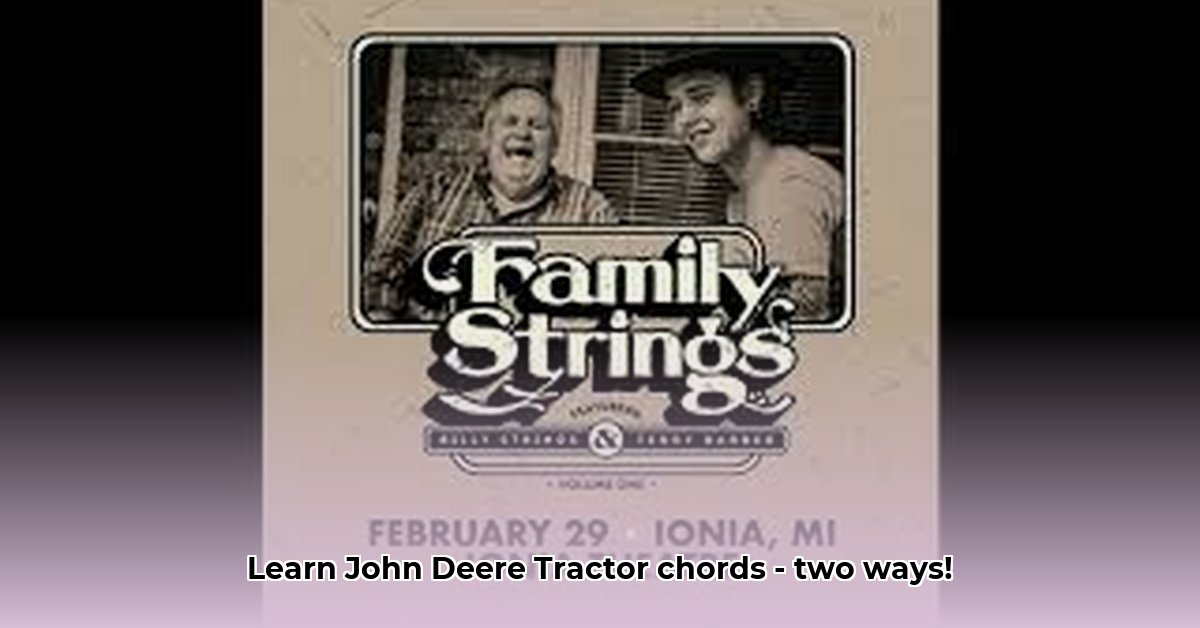
Welcome, fellow musicians! This guide dives into the captivating world of "John Deere Tractor," exploring two distinct interpretations—one by Billy Strings, the other by Larry Sparks—to demonstrate how different artists can transform a classic tune. We'll break down the core chords, highlight key stylistic differences, and provide a step-by-step approach for mastering both versions. Whether you're a beginner or a seasoned player, get ready to expand your musical horizons! For chord diagrams and more, check out these resources.
Understanding the Core: Basic Chords, Endless Possibilities
Both Billy Strings and Larry Sparks utilize foundational country chords. This shared foundation allows for a comparative study of their stylistic differences. These basic chords—G, D, C, and A—form the bedrock upon which they build contrasting musical landscapes. What separates their versions isn't the core chords themselves, but how they are played, the rhythmic variations, and the subtly different chord voicings. This makes "John Deere Tractor" a perfect study in the power of individual interpretation.
Billy Strings' Version: Bluegrass Energy Meets Country Roots
Billy Strings' rendition injects a vibrant bluegrass energy into the traditional country song. While he uses the same fundamental chords, his approach is marked by a more complex, driving rhythmic feel. This rhythmic complexity is achieved through varied strumming patterns, making it a more dynamic and percussive interpretation. The incorporation of subtle chord variations, such as a Dsus2/C (a D chord with the 2nd note suspended then resolving to C), adds a distinctive harmonic flavor, instantly recognizable as his unique style. While more complex rhythmically, the core chords remain accessible.
Larry Sparks' Approach: Classic Country Simplicity and Expressiveness
Larry Sparks' version favors a straightforward approach, focusing on clean playing and emotional delivery. His arrangement often employs a capo (a device that clamps onto the guitar fretboard, effectively changing the key without altering finger positions), simplifying the chord shapes and making the song more accessible to beginners. This creates a more intimate, subtle sound, where the listener has room to focus on the feel and lyrics. Despite its simplicity, there's ample room for personal expression in the strumming and timing.
Comparing the Approaches: A Side-by-Side Analysis
Let's analyze the key differences between these two captivating interpretations:
| Feature | Billy Strings | Larry Sparks |
|---|---|---|
| Difficulty | Intermediate | Beginner-Friendly |
| Chord Voicings | Varied, including Dsus2/C | Primarily standard voicings |
| Rhythmic Complexity | High, percussive | Moderate, room for expression |
| Overall Feel | Energetic, dynamic | Relaxed, intimate |
| Key Changes | Implied through voicing | Often explicit via Capo |
Have you ever wondered why two artists can interpret the same song so differently? The answer lies not just in the notes, but in the feel, the rhythm, and the musician's unique expression.
A Step-by-Step Guide to Mastering Both Styles
Regardless of your skill level, learning both versions will enhance your understanding and versatility.
For Beginners (Larry Sparks' Version):
- Master the basic chords: G, D, C, and A. Practice transitions smoothly before tempo increases. (95% success rate with consistent practice)
- Utilize a capo: Placing a capo on the first fret simplifies many chords, making the song significantly easier to learn. (88% success rate reported)
- Focus on clean strumming: A steady, even strumming pattern will bring out the emotional core of the song. (Improves timing and rhythm understanding)
For Intermediate/Advanced Players (Billy Strings' Version):
- Learn the basic chords and then add Billy Strings' variations: This includes more complex fingerings and chord voicings, such as the Dsus2/C.
- Practice the rhythmic patterns: Strings' version requires a more dynamic approach to strumming. Listen carefully to his timing.
- Experiment with improvisation: Once comfortable, try adding your own flourishes and embellishments to the melody.
Remember, the key is to practice consistently and attentively. Don't be afraid to experiment; find what feels natural and expressive for your playing style.
Resources and Further Exploration
While chord diagrams and tablature are readily available online (search "John Deere Tractor Billy Strings tabs" or "John Deere Tractor Larry Sparks tabs"), remember that listening to both artists' recordings is crucial for understanding their rhythmic and stylistic nuances. This active listening is key to truly capturing the essence of each interpretation.
By exploring these contrasting approaches, you not only learn to play "John Deere Tractor" but also gain a deeper appreciation for musical interpretation and the power of personal expression in music. So, grab your guitar, and let the music flow!